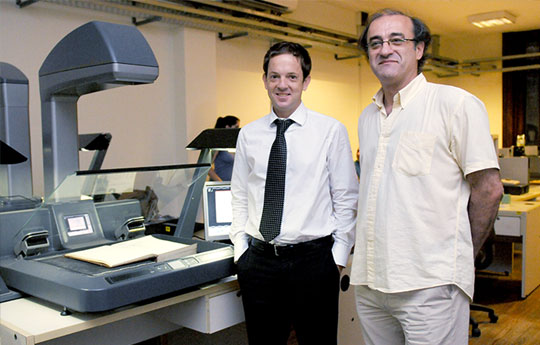TECHNOLOGY TRANSFER OFFICE
CONICET researchers work on the digitalization of the Archivo General de la Nación (National Archive of Argentina)
This research aims to preserve and democratize the heritage of one of the largest documentary collections in the country.
Acts of government of the Virreinato del Río de la Plata, photographs of the building of the Buenos Aires port, archive newsreel films of the 40’s. These are only some parts of the current inventory of Argentine history.
The Archivo General de la Nación Argentina (AGN) is the institution that gathers, organizes and preserves the memory of Argentina. The preservation of this bibliographic and photographic heritage is vital to build the identity of the country.
Juan Pablo Zabala, CONICET assistant researcher at the Instituto de Estudios Sociales de la Ciencia y Tecnología (IESCT- UNQ), and current director of AGN, undertakes a digitalization project of documentary collection such as manuscripts, photographs, audio and video files from colonial times until now.
“I was called in 2008 to analyze the best strategies to intervene in the Archive, and thus we developed a programme, which included the digitalization, as it was basically planned, and more. We designed a modernization project that comprises several lines of action: cataloguing, normalization, preservation of documents, place of the warehouses and, future website”, Zabala highlights.
For his part, Fernando Boro, main professional of CONICET at the Instituto de Historia Argentina y Americana “Dr. Emilio Ravignani” (IHAYA, CONICET-UBA) and member of the team, stresses the importance of preserving the sources, which are the only scarce raw material the community has to reconstruct its past and promote historiographical debates among the researchers. The idea is that they could consider digitalization as a procedure to promote the survival of the records.
“Digital technology allows a better preservation, both in the short and long term, and the access is democratic. With internet, this will be even broader. We aim to safeguard the memory of Argentina for us and the future generations, with the most modern technologies and international experience available”, he affirms.
The passage from documental sources to the digital format not only promotes a better preservation but also enables a number of users to simultaneously visualize and select easily and quickly photographical, audiovisual and bibliographical material in a simpler way and with a superior quality. Likewise, the digital content is planned to be published in the web site of the AGN to make it more accessible.
Luis Priamo, expert on old photography and the Archive’s consultant, accounts for the differences with the previous methodology: “Digitalization is a practical advantage for the researchers. In the past, we had to photograph the originals, what led to a constant deterioration of the materials, or ask the AGN to make a photo reproduction with analogue cameras, like in the olden days, and wait days to have them. Today, we consult on-screen, preserve the originals and get the pictures on the same day”.
Zabala’s team not only devoted themselves to the digitalization but also previously worked on the adoption of international archive legislation for the description of the materials. In order to understand the historical context of the archive, the team conducted a previous institutional study to organize the collection according to the provenance of the materials.
According to Zabala, due to the large scale heritage of the AGN, the researchers decided to establish selection criteria when intervening in the archive. They took into account the description of the archives, the level consultation and conservation status of the sources. The idea was to give priority to those that present greater physical risk considering also their description and the level of consultation.
The implementation of this project included the purchase of specialized scanning equipment that promote an adequate management without deterioration of the parts and the development of the software that digitally replicates the structure of the international archive legislation for the description. Besides, the AGN as governing body of archive matters of the Argentine public administration provides advice for different national institutions.
“Digitalization represents a significant step. It is not only about purchasing the equipment and pushing buttons, it is a long term and digital preservation strategy. With good digitalization equipment and trained operators, these machines can produce on a large scale and with high quality”, Boro concludes.
- By Cecilia Leone.
